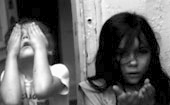Consisting of several black and white home videos taken by William Eggleston around the city of Memphis in 1974 using a modified Sony Porta-pak handheld camera (and occasionally accompanied by Eggleston’s interstitial voice-over narration that provides contextual or anecdotal point of reference to the episode), Stranded in Canton provides a glimpse into what Amy Taubin would describe in the subsequent Q&A as the view from the outside margins of Eggleston’s photography – the periphery of an artist’s gaze. Unfortunately, the subjects of the gaze are not particularly interesting – often vulgar, pompous, crass, intoxicated, incoherent, under the influence of psychotropic drugs, or perpetually hamming it up before the camera to attract attention – the resulting pastiche is perhaps only notable for the unremarkability of its lowbrow subjects, uninspired shot compositions, and almost grotesque imagery (an infrared translucency optically distorts much of the physical features in the film, particularly eyes and skin textures that appear to fluoresce) given the film’s almost legendary status in certain creative circles. The title is taken from an over-the-top, dramatic impromptu monologue delivered in the film by a transvestite eccentric (whose indescribably bad impersonation borders on caricature), an articulation of exotic otherness and desire for transcendence away from the humdrum of a working-class Memphis bar. Nevertheless, while Stranded in Memphis may have been a more appropriate title, Eggleston’s meandering and unstructured film is also too particular in its ensemble of quintessentially lowbrow subjects to serve as an ethnographic study of Memphis circa 1974. Suffice it to say, while Eggleston may be able to find beauty in the composition of mundane objects in his photographs, the translation to film results in a more anecdotal rather than revelatory insight towards the aesthetic deconstruction of Eggleston’s gaze.
© Acquarello 2006. All rights reserved.
